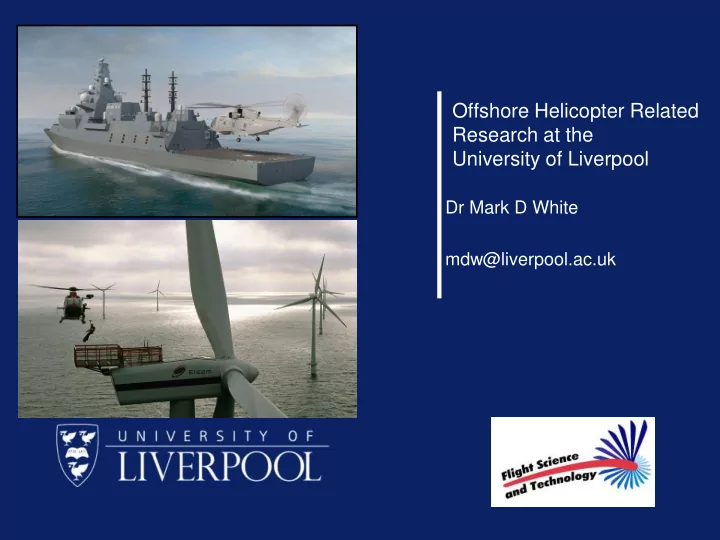

Offshore Helicopter Related Research at the University of Liverpool Dr Mark D White mdw@liverpool.ac.uk
FS&T RESEARCH CAPABILITIES – FLIGHT SIMULATION Modelling & Simulation – Simulation fidelity; development of criteria and validation methods for rotary wing aircraft – Helicopter interactions with turbulent wakes, vortex wakes of fixed wing aircraft and ship airwakes – NATO AVT- 296 “Rotorcraft Flight Simulation Model Fidelity Improvement and Assessment” – 3.5 year EPSRC Rotorcraft Simulation Fidelity Project Aircraft HQ and Flight Control – Helicopter control and handling qualities research, handling qualities in degraded conditions and structural load alleviation concepts Advanced Configurations – Handling qualities and control of tilt rotor aircraft – handling qualities criteria, flight control systems, control laws – Aircraft-pilot couplings and pilot in the loop oscillations; criteria and design solutions Visual Perception and Displays – Design of vision aids for fixed wing and rotary wing flight in degraded visual environments – Pilot-vehicle interface technologies
HELICOPTER SHIP DYNAMIC INTERFACE
Helicopter-Ship Dynamic Interface Funding: QQ, dstl, MoD, BAE, AW/LH Questions: • Can flight simulation be used to inform the determination of Ship Helicopter Operation Limits (SHOLs)? • Can it provide a safe and realistic environment for pilot training? • How can simulator activities inform the design of new ships? • What are the fidelity specifications required to achieve the above?
Creating the Simulated SHOL Simulated SHOL Unstructured, Time- Accurate CFD data (Fluent) FLIGHTLAB Rotorcraft Model Motion Base Flight Sim Maritime Visual Environment Ship Motion
HELIFLIGHT-R • A high quality motion base simulator • A flight mechanics mathematical model of a maritime helicopter • Visual Scene • Ship model and ship motion • An accurate unsteady airwake SHOL Research Summary Modelling the airwake Required level of visual scene content Ship Design for improved DI operations Assessment of motion fidelity Use of UoL Simulator Fidelity Rating Scale
T23 Airwake
CFD Airwake Analysis Deck-edge vortices Slow rotating core ⚫ Vortex aligned with ⚫ SFS2 SF flow direction High speed vortex core ⚫ Aligned longitudinally ⚫ with deck Vortex expands radially Type 23 23 ⚫ towards the stern
Unsteady Airwakes Type 23 Frigate Wave Class Auxiliary Oiler Type 45 Destroyer
Future Combat Ship Superstructure Aerodynamics • Effect of geometric features on airwake & helicopter • Anemometer placement • Engine exhaust efflux • RWUAS
Exhaust Plume Analysis, Headwind Isosurfaces of Exhaust Temperature for Headwind WOD Temperature criteria domain as defined by CAP 437 Mean CFD Data Merlin in high hover position with underslung load Instantaneous CFD Data Merlin in conventional hover position
Exhaust Plume Analysis Temperatures remain at elevated levels above the flight deck, in this case at 350% hangar height (28 m).
Queen Elizabeth Carrier Flight Simulation • Work with BAE to produce QEC flight simulation environment at Warton and Liverpool, 2 PhDs • Create validated airwakes • Develop techniques for handling large airwakes • Develop generic STOVL flight mechanics model
QEC Flight Simulation Creation of CAD model for: • CFD – unsteady airwake for flight simulation • Experimental model (1.4m long) for 3-D velocity measurements in water tunnel QEC 1:202 – mean w -component velocity along SRVL glideslope.
Initial UoL Sim Testing 2 x 2 day trials with ex-RN Test Pilots NATO AVT- 315 “Comparative Assessment of Modelling and Simulation Methods of Shipboard Launch and Recovery of Helicopters”
Future Dynamic Interface Challenges Try and answer the question: “How good is • good enough?” Rotor/wake/moving deck interactions • Visualisation of Rotor/Airwake • Simulator motion tuning • Ship Design Guidelines for Improved • Rotorcraft operations Develop “Hazardous” Training Landscape • Tall building helipads Oil rig heli-deck simulation Search and Rescue training
ROTORCRAFT/WIND TURBINE WAKE ENCOUNTERS
General Aviation Aircraft Encounters with Helicopter and Wind Turbine Wakes • Joint project between UoL and UK CAA • Select appropriate wake model for rotorcraft and wind turbines • Carry out simulated flight trials to assess hazard posed by different wakes Free-wake simulation of the Dauphin rotor • Couple the wake of the rotary wing and fixed wing aircraft • Dauphin & Grob Tutor • Present guidelines for the separation distance from helicopters and wind turbines
Piloted Simulation Trial 3 Diameter position Results: A most severe case. Rating D/F Objective assessment of data, looking at roll criteria, control power etc.
Existing Wind Turbine Installations East Midlands Airport Caernarfon Airport 14.01.13
HC/AG-23 Status ◼ Wind turbine wake and helicopter operations Project duration: 3 years, Kick-off 6 November 2014, DLR-Braunschweig Objectives To understand the behaviour of helicopters in a wind turbine wake ◼ To identify the safety hazards of helicopter wind turbine wake encounters ◼ To define measures to mitigate identified safety issues ◼ By Analysing helicopter dynamics on wind turbine wake encounters ◼ Providing guidance to mitigate safety hazards ◼ Providing recommendations for legislation ◼ Disseminating the findings to the appropriate authorities and parties concerned ◼
• Wake Vortex Encounter scale used for rating D – corrective action requires immediate and considerable pilot effort
Mark White University of Liverpool Coordinator
THE PARTNERSHIP
ESR 7 Mitigation of Airwake Hazards ULIV + UoG ULIV: Mark White UoG: George Barakos
Key Problem ESR7 Tools and strategies to reduce the threat posed by wake encounters are lacking in the helicopter community. What safety metrics and standards need to be developed to improve safety of rotorcraft operations in turbulent environment? How can technology (hardware and software) and training be used to reduce the risk of an incident when operating in such environments?
Research Outcomes ESR7 develop new training and operating paradigms to improve rotorcraft safety in “turbulent” environments. develop and demonstrate the tools needed to provide a pilot with a real-time wake information capability produce a synthetic display to aid the pilot’s ability to manage the risk during operations in turbulent environments develop new methodologies for characterising the hazard presented by airwakes and assess the fidelity requirements for airwakes for use in piloted simulation activities
Offshore Helicopter Related Research at the University of Liverpool Dr Mark D White mdw@liverpool.ac.uk
Development of Severity/HQ Criteria
Recommend
More recommend